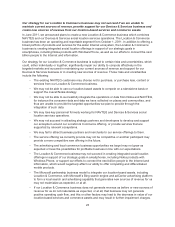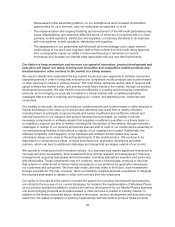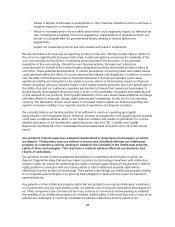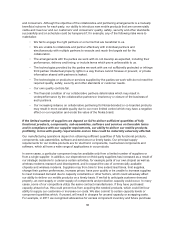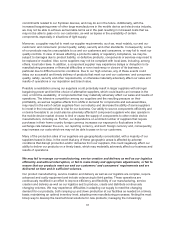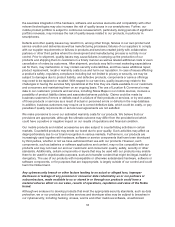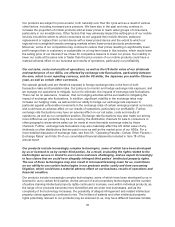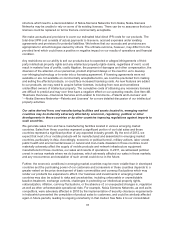Nokia 2011 Annual Report Download - page 33
Download and view the complete annual report
Please find page 33 of the 2011 Nokia annual report below. You can navigate through the pages in the report by either clicking on the pages listed below, or by using the keyword search tool below to find specific information within the annual report.commitments related to our Symbian devices, and may do so in the future. Additionally, with the
increased bargaining power of other large manufacturers in the mobile device and electronics industry,
we may not be able to achieve as favorable terms as in the past resulting in increased costs that we
may not be able to pass on to our customers, as well as lapses in the availability of certain
components, especially in situations of tight supply.
Moreover, a supplier may fail to meet our supplier requirements, such as, most notably, our and our
customers’ and consumers’ product quality, safety, security and other standards. Consequently, some
of our products may be unacceptable to us and our customers and consumers, or may fail to meet our
quality controls. In case of issues affecting a product’s safety or regulatory compliance, we may be
subject to damages due to product liability, or defective products, components or services may need to
be replaced or recalled. Also, some suppliers may not be compliant with local laws, including, among
others, local labor laws. In addition, a component supplier may experience delays or disruption to its
manufacturing processes or financial difficulties or even insolvency or closure of its business, in
particular due to difficult economic conditions. Due to our high volumes, any of these events could
delay our successful and timely delivery of products that meet our and our customers’ and consumers’
quality, safety, security and other requirements, or otherwise materially adversely affect our sales and
results of operations or our reputation and brand value.
Possible consolidation among our suppliers could potentially result in larger suppliers with stronger
bargaining power and limit the choice of alternative suppliers, which could lead to an increase in the
cost, or limit the availability, of components that may materially adversely affect our sales and results of
operations. The intensive competition among our suppliers and the resulting pressure on their
profitability, as well as negative effects from shifts in demand for components and sub-assemblies,
may result in the exit of certain suppliers from our industry and decrease the ability of some suppliers
to invest in the innovation that is vital for our business. Our ability to source components efficiently and
on terms favorable to us could also be adversely affected if component suppliers who also operate in
the mobile device market choose to limit or cease the supply of components to other mobile device
manufacturers, including us. Further, our dependence on a limited number of suppliers that require
purchases in their home country foreign currency increases our exposure to fluctuations in the
exchange rate between the euro, our reporting currency, and such foreign currency and, consequently,
may increase our costs which we may not be able to pass on to our customers.
Many of the production sites of our suppliers are geographically concentrated, with a majority of our
suppliers based in Asia. In the event that any of these geographic areas is affected by adverse
conditions that disrupt production and/or deliveries from our suppliers, this could negatively affect our
ability to deliver our products on a timely basis, which may materially adversely affect our business and
results of operations.
We may fail to manage our manufacturing, service creation and delivery as well as our logistics
efficiently and without interruption, or fail to make timely and appropriate adjustments, or fail to
ensure that our products meet our and our customers’ and consumers’ requirements and are
delivered on time and in sufficient volumes.
Our product manufacturing, service creation and delivery as well as our logistics are complex, require
advanced and costly equipment and include outsourcing to third parties. These operations are
continuously modified in an effort to improve efficiency and flexibility of our manufacturing, service
creation and delivery as well as our logistics and to produce, create and distribute continuously
changing volumes. We may experience difficulties in adapting our supply to meet the changing
demand for our products, both ramping up and down production at our facilities as needed on a timely
basis; maintaining an optimal inventory level; adopting new manufacturing processes; finding the most
timely way to develop the best technical solutions for new products; managing the increasingly
31




